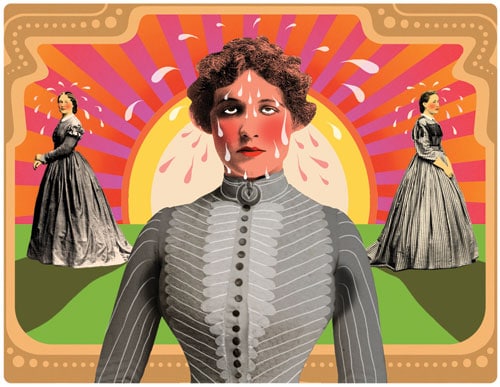
Prairie Fire
Q: How do the Conner Prairie reenactors keep from passing out on hot days? Those hoop skirts don’t look practical.
Ashlie P. Carmel
A: The Hoosierist, who often accompanies his son to this 19th-century living-history museum, has also wondered how real pioneers, encumbered by so much muslin and wool in the summer, ever summoned the stamina to do any actual pioneering. However, Aili McGill, director of operations at Conner Prairie, says the warm weather isn’t quite the nightmare we “moderns” imagine it to be. And she should know. Before taking a desk job, she spent a decade schlepping around the grounds as a costumed interpreter, swathed in stockings, two petticoats, a cotton dress, an apron, a neckerchief, and a bonnet. And she didn’t keel over once.
“It’s kind of counterintuitive, but once you’re used to wearing the historic clothing, it’s simply not that bad in the heat,” McGill swears.
The duds are mostly made of breathable fabric, and once you sweat through your undergarments (which takes maybe 15 seconds on hot days), the moisture actually cools the wearer. All those acres of fabric also keep the hot sun off of their skin, and even serve as insulation if they’re, say, working over an open fire. Not that staffers don’t practice a few additional cool-down tricks, such as wearing water-soaked neckerchiefs. “I’ve even watched some ladies drop ice cubes down their corsets on really hot days,” McGill says. Now that’s family entertainment.
Q: Whatever happened to the Peace Games in Indianapolis?
Bobby N., Fishers
A: This long-running summer athletic extravaganza was canceled a few years ago due to lack of interest—a lack of interest so profound that, until this query crossed his desk, The Hoosierist didn’t even realize they were gone. Which is sort of surprising, given the event’s former stature. During Indy’s darker days, they were pretty much the biggest and only thing in town.
Established in 1972 and named for the Vietnam peace treaty, which was signed on the same day plans for the competition were finalized, the Peace Games pitted amateur athletes from Indianapolis and Scarborough, Canada, against each other in a slate of events. They were held in each city on alternate years and promoted fellowship and cultural exchange between Indy and the suburb of Toronto. Because apparently, back in the early ’70s, there was a desperate need to better understand those inscrutable Canucks up north.
The games chugged on merrily through the ’70s and early ’80s, but attendance dropped precipitously once we had better things to attend, like Colts games. And perhaps we discovered that our “cultural differences” with Canadians just weren’t that profound—beyond their peculiar national mania for hockey (booooring). The Peace Games were officially laid to rest in 2004.
Q: Is the stuff available at farmers markets inspected in any way, or is it strictly caveat emptor?
Vicki W., Indianapolis
A: The Hoosierist, though a fan of such places, has nevertheless occasionally wondered if anyone examines all those dirt-encrusted turnips and potatoes and blueberry muffins (well, maybe not those) arrayed on folding tables every Saturday morning from spring to fall. The answer, he learned to his great relief, is yes. Before each market begins its season, the Marion County Public Health Department hits it up for a complete list of vendors, inspects the joint on opening day, and then returns for a surprise sweep at a later date. “It’s pretty tightly regulated,” says health department spokesman John Althardt. “They’re subject to inspection, just like any other licensed food facility in the county.”
Althardt says he receives few complaints about farmers markets. However, if you find, say, a dirt-encrusted blueberry muffin at yours, you should do exactly what you’d do if you spotted a fly in your soup at a fancy restaurant—call the health department.
Q: The Indy metro area seems like the world capital of retention ponds. What are they for?
Jean O., Indianapolis
A: It’s impossible to say if Indy has more retention ponds than other cities its size, but it certainly appears that way. Especially if you glance out of your airplane’s window during final approach into Indianapolis International Airport. All the glittering puddles beneath you might make you think you were landing in northern Minnesota, that Land O’Lakes place where the grocery-store butter comes from.
Except in Minnesota, all the lakes aren’t surrounded by housing developments and strip centers like ours. The reason for this, according to Natalie Derrickson, outreach coordinator for the Indianapolis Department of Public Works, is that locations lousy with parking lots, half-acre roofs, and concrete roads tend to repel water as efficiently as the hood of a freshly waxed car. Which generates torrents of runoff every time it rains. To avoid overwhelming the storm sewers, the water shed into the watershed by all that concrete and asphalt gets shunted into purpose-built reservoirs, where it travels through pipes into the ground.
Most of these “ponds” aren’t exactly recreation spots. Some are loaded with dangerous pollutants carried in by the rain, while others are so small, unsightly, and weed-choked that they’re hidden behind privacy fences. But that’s not always the case. According to Derrickson, Lake Clearwater near Keystone at the Crossing is just a glorified retention pond—as is, believe it or not, Eagle Creek Reservoir.
Illustration by Shane Harrison.
This column originally appeared in the July 2012 issue.





